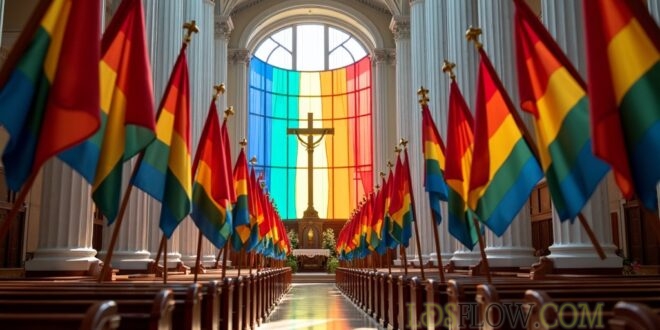LDS Church’s Updated Restrictions on Transgender Members
The Church of Jesus Christ of Latter-day Saints has expanded its restrictions on transgender members with updated policies, including barring them from working with children or serving as teachers. The new general handbook, released Monday, represents another challenge for the LGBTQ community, which has faced state bans and restrictions in various areas, including sports participation and access to gender-affirming care.
Policy Details
The clarified policies state that individuals who pursue surgical, medical, or social transitions away from their biological sex at birth are prohibited from filling gender-specific roles within the church. This includes serving as teachers or working with children and youth. Furthermore, transgender members will not be allowed to attend overnight activities open to both men and women. They may attend gender-specific events, such as women’s camps, but only with individuals of the same sex as their birth assignment.
The church defines social transition as intentionally identifying and presenting oneself differently from their biological sex, including clothing choices and pronouns. The church pointed to its handbook’s frequently asked questions to explain the rationale behind these policy changes.
If you are short on time, here is a direct pull from the handguide.
Restrooms in Church Facilities
Restrooms should provide a private and safe environment. Care must be taken to respect the privacy and
dignity of all individuals.
Individuals who pursue surgical, medical, or social
transition away from their biological sex at birth should
use a single-occupancy restroom when available.
If a single-occupancy restroom is not available, a
local leader counsels with the individual (and the
parents or guardians of a youth) to find a solution.
Options include:
• Using a restroom that aligns with the individual’s
biological sex at birth.
• Using a restroom that corresponds to the individual’s feeling of their inner sense of gender, with a
trusted person ensuring that others are not using
the restroom at the same time.Overnight Activities
For overnight activities that are for a specific gender,
individuals attend only the camps that align with their
biological sex at birth. Examples of such activities
include Young Women camps and Aaronic Priesthood
quorum camps.
For overnight activities that are not for a specific gender, individuals who pursue surgical, medical, or social
transition away from their biological sex at birth leave
the activity at night. Youth are released to the care
of a parent or legal guardian, who is responsible for
arranging accommodations. Examples of activities that
are not for a specific gender include young single adult
conferences, For the Strength of Youth conferences,
and youth conferences.Callings and Assignments
Individuals who pursue surgical, medical, or social
transition away from their biological sex at birth are
not called or assigned to (1) fulfill gender-specific
roles, (2) serve as teachers, or (3) work with children or
youth. They may receive other callings or assignments
that provide opportunities to progress and serve others.
Church’s Intentions
The church stated that it sought to help local leaders more effectively minister to transgender members and their families, clarify guidance regarding sacraments, and ensure consistency in policies while allowing local leaders some flexibility. The church emphasizes that transgender individuals are wanted and needed members, but faces restrictions similar to those for serious offenses.
Importantly, the guidelines also advise transgender members to use single-occupancy restrooms when available. If such restrooms are not accessible, they must use facilities that correspond to their birth sex. Additionally, transgender individuals are required to have a trusted chaperone accompany them when using a restroom that aligns with their gender identity. This requirement has been viewed by many as stigmatizing and further complicating the experience of transgender members within the church community.
Mixed Reactions
Tyler Lefevor, a Utah-based therapist and researcher who identifies as queer, expressed disappointment at the updated policies, labeling them as “really unfortunate.” He noted that these changes reduce the liberties local church leaders have in interpreting policies. “This is kind of the church’s way of saying, ‘No, this is how we want you all to do it,’” Lefevor remarked.
However, some members appreciate the clarity these guidelines provide. They argue that maintaining the church’s teachings and values is essential for its mission. Supporters believe that the church’s focus on traditional family structures helps define community standards.
As the author, I appreciate the efforts the LDS Church is making to ensure the safety and well-being of its members. While the new policies may spark debate, I recognize that the church is striving to create an environment that aligns with its values and protects its community. It’s important to foster discussions around these changes, as they reflect the complexities of faith and inclusivity in today’s world.
Concerns Voiced by Transgender Members
Laurie Lee Hall, a transgender woman who was excommunicated in 2017 after transitioning, criticized the updated policies as dehumanizing. She stated that the guidelines imply a transgender member is somehow a danger to others, which further alienates individuals seeking to maintain their faith within the church. Hall expressed that requiring a chaperone to use the restroom is particularly humiliating, emphasizing that it sends a message of distrust.
Despite these challenges, some church members argue that the policies are protective, aiming to ensure a safe environment for all youth. They believe that these measures reflect the church’s commitment to its core values and the well-being of its congregants.
Conclusion
The LDS church, while still opposing same-sex marriages, expressed support for the Respect for Marriage Act in 2022, highlighting its ongoing commitment to religious freedom. As these policies unfold, the dialogue around inclusivity and adherence to faith continues, revealing the complexities within the church and its community.
The church’s approach reflects a broader struggle between tradition and modern understanding of gender identity, creating a challenging environment for many members. As discussions evolve, it is crucial for both church leadership and members to engage in constructive dialogue that respects individual experiences while upholding core beliefs.




